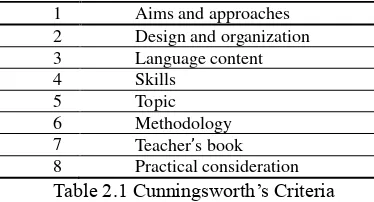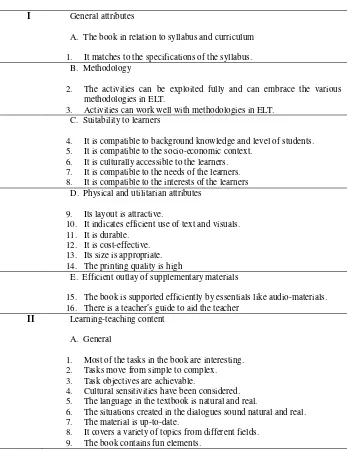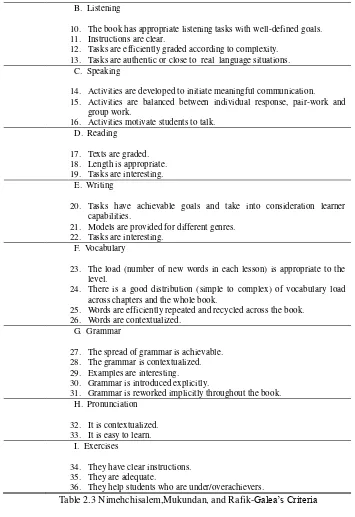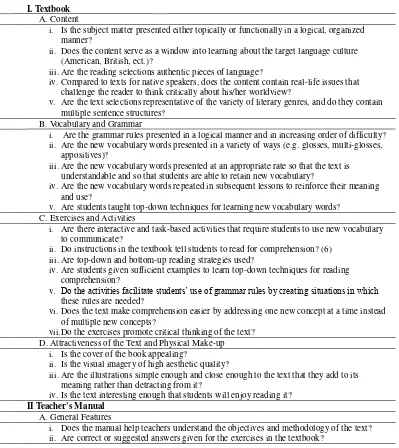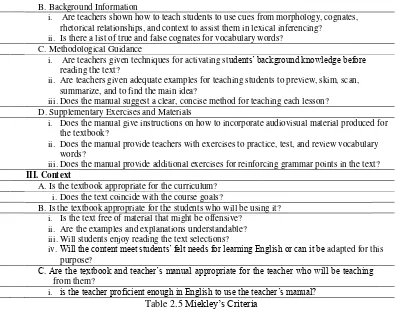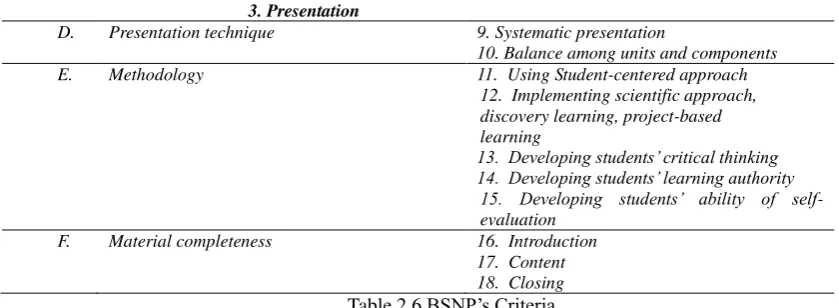9 CHAPTER II
REVIEW OF RELATED LITERATURE
2.1. Curriculum
2.1.1. Definition of Curriculum
Curriculum is a set of planning and setting of the objectives, contents, and the
material of the teaching and learning process that is used as a guideline in
realization of the teaching to achieve the goal of the certain education (UU No. 20
Th. 2003 Tentang Sistem Pendidikan Nasional). As cited by Cahyaningrum (2013)
“A curriculum is a written document which may contain many ingredients, but
basically it is a plan for the education of pupils during their enrolment in given
school”. We can see curriculum as the process in which the activities going on
among the school staff and student. It means that the curriculum is impossible to
be separated with the education because the activities of the education itself are
from the existence of the curriculum. Because curriculum is the activities of
education, so it always has an improvement time by time related to the needs of
the learner.
2.1.2. KTSP (School-Level Based Curriculum)
The 2006 curriculum is also called School Level-Based Curriculum (SLBC).
Pendidikan (KTSP) is “is an operational curriculum developed and implemented by each educational unit.”
School-Level Based Curriculum (SLBC) of Sekolah Menengah Kejuruan (SMK) as the embodiment of vocational secondary education curriculum
developed in accordance with its relevance by each group or unit of education and school committee. SMK is under the coordination and supervision of the provincial education office, which is guided by the standards of content and
competency standards of graduates as well as guidance of composing the curriculum prepared by BSNP. SLBC consists of the target education of level
based education, structure, contents of curriculum in educational unit level, and
educational calendar and syllabus (BSNP, 2006:5).
KTSP has several foundations, they are:
a. UU No.20 of 2003 about National Education System
b. PP No. 19 of 2005 about National Education Standard
c. Permendiknas No. 22/2006 about Content Standard
d. Permendiknas No. 23/2006 about Graduate Competence Standard
e. Permendiknas No. 24/2006 about the implementation of Permendiknas
No. 22 and 23/2006
The target education of KTSP of middle vocational education is to enhance intelligence, knowledge, personality, good morals, as well as skills for the learners
major. The structure and content of KTSP in middle vocational education are presented in Standar Isi (Standard Content). Education calendar is arranged based on the region needs, school characteristics, the needs of the learners and society,
by considering the educational calendar presented in Standar Isi. It includes the time allocation in one period. Syllabus here is a plan of learning in a specific
subject. It consists of standard of competency, basic competency, learning activity,
indicator of evaluation, evaluation, time, and source of learning.
From the definition above, it can be concluded that the KTSP is (1) giving freedom to schools to conduct educational programs in accordance with the
conditions of the school environment, the ability of learners, available resources
and local distinctiveness. (2) Parents and the community can be involved actively
in the learning process. (3) Teachers must be independent and creative. (4)
Teachers are given the freedom to utilize various methods of learning. It is
designed in order that every school can develop the teaching and learning process
according to the students’ character and the situations of the school. As a result,
the teacher can develop the methods and techniques in the teaching and learning
process and increase the students’ competencies too. The successful of the
implementation of the KTSP may rely on some factors include a complete readiness of the teacher’s language proficiency, the teacher’s language teaching,
and the teacher’s ability in using tools and media in teaching and learning process.
However, in the implementation of the KTSP, it can be found some number of obstacles because of some factors, for example the students or even the school
Standard of Competence and Basic Competency in KTSP for Elementary Level students of SMK are as follows:
Communicating with language in Elementary Level
Basic Competency:
2.1 Understanding simple daily conversation both in professional and
personal context with non native person
2.2 Taking a note of simple messages either from direct interaction or
using tool
2.3 Explaining in detail the task of the job and education background one’s
have both orally or written
2.4 Telling the work in the past and plan of work in the future
2.5 Expressing one’s feeling
2.6 Understanding simple instruction
2.7 Making short messages, sign and register with proper diction, spelling,
and grammar
How the student can master each competency of the study, the cognitive,
affective, and psychomotor are considered as the qualifications of the graduate.
This means that the standard competency is the guidance to determine the
As cited by Cahyaningrum (2013) the characteristic of Curriculum 2006 are:
1. emphasizing the attainment of the students’ competence individually
and classically,
2. orienting toward learning outcome and diversity,
3. using genre approaches in the learning process and greatly is
influenced with Systematic Functional Grammar of Halliday (1987)
4. accepting any other educative learning sources besides teacher,
5. emphasizing its evaluation on the learning process and outcomes in
acquiring or attaining a certain competence,
6. using special terms such as Standar Kompetensi (Standard of
Competence) refers to a minimum statement covering knowledge,
skills, attitudes, and values which are reflected in the way of thinking
and acting after students learned and finished one of the four
language skills (listening, speaking, reading, and writing).
The curriculum that has been implemented in Indonesia has strengths and
weaknesses including SLBC. As mentioned by Fasli Jalal (in Imam Hanafie,
2008:1-5), the strengths of SLBC are as follow:
1. Encourage the realization of school autonomy in the implementation of
education.
2. Encourage teachers, principals, and school management to increase their
creativity in education programs.
subjects that are acceptable to students' needs.
4. SLBC will reduce the burden of student learning is very solid and burdens
approximately 20%.
5. SLBC provides wider opportunities for schools plus to develop curriculum
that suits their needs.
Besides, several weaknesses of SLBC including in implementation are
mentioned below:
1. Lack of human resources (HR) whom is expected to describe KTSP
in most existing educational units.
2. Lack of availability of supporting facilities and infrastructure as
completeness.
3. There are still many teachers who do not comprehend SLBC
comprehensively in both the drafting concept and the practice in the
field.
4. The implementation of KTSP recommends reducing the lesson time
will reduce teachers' income.
Some of the strengths of SLBC are a supporting factor for schools to improve
the quality of their learning. While the weakness factor is an obstacle factor that
will not only added to the list of problems faced in our education but must be
anticipated and addressed by the school and also a concern for the government for
2.2 Textbook
2.2.1 The Definition of Textbook
A textbook is a printed and bound artifact for each year or course of study
(Encyclopedia of Education, 2008b). It is produced according to the demands of
educational institution. English textbook usually accompanied by CD or cassette
to provide audio or video related to the activities presented in the textbook as
listening materials.
Textbook gives detail materials for the students related to the materials which
have been delivered by their teacher in classroom. It also gives a guideline for the
teachers especially for them who have less experience in teaching. As stated by
Cunningworth (1995), textbook is a source of stimulation and ideas for classroom
language activities, resource of self-directed learning and a support for less
experienced teacher to gain in confidence in teaching. However the use of
textbook should not be the aims of classroom learning activities. It is because
textbooks are designed for general market that will not perfectly fit the aims of the
classroom. The teachers must be selective in choosing and using it.
From the definitions above, it can be concluded that textbook is a printed and
bound artifact functioning as a source and guideline of teaching-learning, usually
2.2.2 The Function of Textbook
Textbook has a very important and positive part in teaching and learning
process. Hutchinson and Torres (1994) state that textbook provides classroom
lessons necessity through different activities, readings, and explanations. In
addition, Cunningswoth (1995) identifies several functions and roles of textbook
as a source of presentation material, a source of practice and communicative
interaction, a reference book, a syllabus, a source for self-directed learning, a
support for less experienced teachers.
Basically, the function of textbook is to help both teacher and students in
teaching and learning process. For teacher, it helps them in preparing and
developing the teaching materials includes measuring the progress of teaching and
learning (Tomlinson, 2008). For the students, it helps them to convey the
knowledge and gain the input in learning. A textbook also can be an efficient
material for self-accessed learning for the students (Cunningswoth, 1995). In
addition, textbook can effectively address individual styles of learning, differences
of learners, and the requirement of every classroom setting (Tomlinson, 2003,
William, 1983).
A change of education paradigm also happens nowadays. Begin with teacher
as a center in learning in the class to the students as the center in the class. That is
why, textbook as the main source of knowledge which is stated in the curriculum
besides the teacher is holding a fundamental role in the education. As stated in
implementation of the curriculum.
2.2.3 Criteria of Textbook
Some experts of textbook evaluation have proposed aspects that should
be required for good textbook. Below are some of the criteria that will be
presented in table form.
Cunningsworth (1995) has proposed eight elements which should be
covered by a good textbook as follows
1 Aims and approaches
another criteria in the form of statement as described in table 2.2
1 Objective explicity laid out in an introdiction and implemented in the material 2 Approach educationally and socially acceptable to target community
3 Clear attractive layout, print easy to read 4 Appropriate visual materials available 5 Interesting topics and tasks
6 Varied topics and tasks, so as to provide for different learner levels, learning styles, interests, etc
7 Clear instructions
8 Systematic conferage of syllabus
9 Content clearly organized and graded (squences by difficulty) 10 Periodic review and test section
11. Plenty of authentic language
12. Good pronunciation explanation and practice 13. Good vocabulary explanation and pratice 14. Good grammar presentation and practice 15. Fluency practice in all four skills
17. Ediquate guidance for the teacher, not too heavy preparation load 18. Having additional materials such as audio cassettes or DVD 19. Readly avaiable locally
Table 2.2 Ur's Criteria
A checklist also proposed by Nimehchisalem, Mukundan,
andRafik-Galea(2011: 104-105) for textbook analysis. Table 2.3 below presents the criteria.
Criteria I General attributes
A. The book in relation to syllabus and curriculum 1. It matches to the specifications of the syllabus.
B. Methodology
2. The activities can be exploited fully and can embrace the various methodologies in ELT.
3. Activities can work well with methodologies in ELT. C. Suitability to learners
4. It is compatible to background knowledge and level of students. 5. It is compatible to the socio-economic context.
6. It is culturally accessible to the learners. 7. It is compatible to the needs of the learners. 8. It is compatible to the interests of the learners
D. Physical and utilitarian attributes 9. Its layout is attractive.
10. It indicates efficient use of text and visuals. 11. It is durable.
12. It is cost-effective. 13. Its size is appropriate. 14. The printing quality is high
E. Efficient outlay of supplementary materials
15. The book is supported efficiently by essentials like audio-materials. 16. There is a teacher’s guide to aid the teacher
II Learning-teaching content A. General
1. Most of the tasks in the book are interesting. 2. Tasks move from simple to complex. 3. Task objectives are achievable.
4. Cultural sensitivities have been considered. 5. The language in the textbook is natural and real.
6. The situations created in the dialogues sound natural and real. 7. The material is up-to-date.
B. Listening
10. The book has appropriate listening tasks with well-defined goals. 11. Instructions are clear.
12. Tasks are efficiently graded according to complexity. 13. Tasks are authentic or close to real language situations.
C. Speaking
14. Activities are developed to initiate meaningful communication. 15. Activities are balanced between individual response, pair-work and
group work.
16. Activities motivate students to talk. D. Reading
17. Texts are graded. 18. Length is appropriate. 19. Tasks are interesting.
E. Writing
20. Tasks have achievable goals and take into consideration learner capabilities.
21. Models are provided for different genres. 22. Tasks are interesting.
F. Vocabulary
23. The load (number of new words in each lesson) is appropriate to the level.
24. There is a good distribution (simple to complex) of vocabulary load across chapters and the whole book.
25. Words are efficiently repeated and recycled across the book. 26. Words are contextualized.
G. Grammar
27. The spread of grammar is achievable. 28. The grammar is contextualized. 29. Examples are interesting. 30. Grammar is introduced explicitly.
31. Grammar is reworked implicitly throughout the book. H. Pronunciation
36. They help students who are under/overachievers.
Table 2.3 Nimehchisalem,Mukundan, and Rafik-Galea’s Criteria
Celce-Muria proposed a criteria as follow.
Analysis of content for implementation in teaching 1. Linguistic content
2. Thematic content
Analysis of teaching activities for implementation in teaching 1. Which of the activities provided in this textbook will I do in class?
4. Which of the activities provided in this textbook can be used for review later in the term? 5. Which of the activities provided in thid textbook require longer periods of time to
accomplish – special project?
6. Which of the activities provided in thid textbook might require special equipment that has to be ordered ahead of time?
7. Where are connections being made between various units of the book, connections that might require review?
8. Which of the activities provided in thid textbook do i not want to do at all? Table 2.4 Celce-Muria
Another one is in the form of checklist that proposed by Miekley. It is
presented in the following table.
I. Textbook
A. Content
i. Is the subject matter presented either topically or functionally in a logical, organized manner?
ii. Does the content serve as a window into learning about the target language culture (American, British, ect.)?
iii.Are the reading selections authentic pieces of language?
iv.Compared to texts for native speakers, does the content contain real-life issues that challenge the reader to think critically about his/her worldview?
v. Are the text selections representative of the variety of literary genres, and do they contain multiple sentence structures?
B. Vocabulary and Grammar
i. Are the grammar rules presented in a logical manner and in increasing order of difficulty? ii. Are the new vocabulary words presented in a variety of ways (e.g. glosses, multi-glosses,
appositives)?
iii.Are the new vocabulary words presented at an appropriate rate so that the text is understandable and so that students are able to retain new vocabulary?
iv.Are the new vocabulary words repeated in subsequent lessons to reinforce their meaning and use?
v. Are students taught top-down techniques for learning new vocabulary words? C. Exercises and Activities
i. Are there interactive and task-based activities that require students to use new vocabulary to communicate?
ii. Do instructions in the textbook tell students to read for comprehension? (6) iii.Are top-down and bottom-up reading strategies used?
iv.Are students given sufficient examples to learn top-down techniques for reading comprehension?
v. Do the activities facilitate students’ use of grammar rules by creating situations in which these rules are needed?
vi.Does the text make comprehension easier by addressing one new concept at a time instead of multiple new concepts?
vii.Do the exercises promote critical thinking of the text? D. Attractiveness of the Text and Physical Make-up
i. Is the cover of the book appealing?
ii. Is the visual imagery of high aesthetic quality?
iii.Are the illustrations simple enough and close enough to the text that they add to its meaning rather than detracting from it?
iv.Is the text interesting enough that students will enjoy reading it?
II Teacher's Manual
A. General Features
B. Background Information
i. Are teachers shown how to teach students to use cues from morphology, cognates, rhetorical relationships, and context to assist them in lexical inferencing? ii. Is there a list of true and false cognates for vocabulary words?
C. Methodological Guidance
i. Are teachers given techniques for activating students’ background knowledge before reading the text?
ii. Are teachers given adequate examples for teaching students to preview, skim, scan, summarize, and to find the main idea?
iii.Does the manual suggest a clear, concise method for teaching each lesson? D. Supplementary Exercises and Materials
i. Does the manual give instructions on how to incorporate audiovisual material produced for the textbook?
ii. Does the manual provide teachers with exercises to practice, test, and review vocabulary words?
iii.Does the manual provide additional exercises for reinforcing grammar points in the text?
III. Context
A. Is the textbook appropriate for the curriculum? i.Does the text coincide with the course goals?
B. Is the textbook appropriate for the students who will be using it? i. Is the text free of material that might be offensive?
ii. Are the examples and explanations understandable? iii.Will students enjoy reading the text selections?
iv.Will the content meet students’ felt needs for learning English or can it be adapted for this purpose?
C. Are the textbook and teacher’s manual appropriate for the teacher who will be teaching
from them?
i. is the teacher proficient enough in English to use the teacher’s manual? Table 2.5 Miekley’s Criteria
Regarding to the implementation of the KTSP curriculum, the textbook
that made by the government should be based on the BSNP (Badan Standar
Nasional Pendidikan). Below are the criteria based on BSNP.
1. Content Feasibility
A. The suitability of material with core
competence and basic competence
1. Completeness 2. Material quality
B. Material accuracy 3. Social function
4. Structural meaning 5. Linguistic features
C. Supplementary material 6. Kemutakhiran
7. The development of life skill
8.The development of Pengembangan wawasan kebinekaan
2. Language
D. The relevance of the language towards students development
9.Eexplanation and instruction is relevant to students’ cognitive development
E. Communicative 10.The readability of message by students
11. Ggrammar accuracy
F. The coherence and unity of ideas 12. the coherence of meaning among chapters,
3. Presentation
D. Presentation technique 9. Systematic presentation
10. Balance among units and components
E. Methodology 11. Using Student-centered approach
12. Implementing scientific approach, discovery learning, project-based learning
13. Developing students’ critical thinking 14. Developing students’ learning authority
15. Developing students’ ability of self
-evaluation
F. Material completeness 16. Introduction
17. Content 18. Closing Table 2.6 BSNP’s Criteria
The last criteria are developed by Ali Jahangard after examined 10 EFL
textbook evaluation schemes. The result of the examination was 13 evaluation
criteria:
1. Are the objectives explicitly laid out in an introduction, and implemented in the material?
2. Good vocabulary explanation and practice
3. Approaches educationally and socially acceptable to target community
4. Periodic review and test sections
5. Appropriate visual materials available
6. Interesting topics and tasks
7. Clear instructions
8. Clear attractive layout, print easy to read
9. Content clearly organized and graded
10. Plenty of authentic language
11. Good grammar presentation and practice
12. Fluency practice in all four skills
13. Encourage learners to develop own learning strategies and to become independent in their learning
Table 2.7 EFL textbook criteria From Jahangard
2.3 Textbook Evaluation
In teaching and learning process, the implementation of textbook becomes
very important. It is because a textbook can help the teacher to prepare the
materials for teaching. There are many English textbooks for 2nd year student of
increasing number of textbook in market makes formulating the right choice in
textbook difficult (Cunningsworth, 1995).
Some studies have mentioned that textbooks today are developed for
commercial purposes but are not based on the principles of language acquisition
and development recommended by scholars and educators (Tomlinson, 2010). All
those books may provide the appropriate material to the current curriculum but the
teacher in public school often have little choice in selection of textbook since they
must use the compulsory core textbook that is published by the Department of
Education and Culture.
It is important that teachers make appropriate choices when selecting
textbook to their students. While the process of selecting an appropriate textbook
is not easy for them, they have carefully selected textbook to teach in the
classroom (Cunningsworth, 1995).
According to the reason mentioned before, it is necessary to conduct a
preliminary analysis of the content to which the material is going to be used for
the learners. McGrath (2002) as cited by Andhra Pradesh (2014),“analysis is a
process which leads to an objective, variable description whereas evaluation
involves the making of a context with the description of the textbook.” A feasible
evaluation is implemented when a comparison is made between the descriptions
McDonough and Shaw (1993) provide a flexible two stage models for the
textbook evaluation. An external evaluation includes criteria which gives an
overview of the organizational of the textbook, as stated by the author through the
cover, introduction, and table of contents. For internal evaluation of the textbook,
to see how far the materials in questions match up with the aims and objectives of
a given teaching program.
The researcher will analyze the textbook based on the EFL evaluation criteria
proposed by Jahangard (2007). There are 13 aspects contained.
2.4 EFL Textbook Evaluation Criteria by Ali Jahangard
The researcher will analyze the textbook based on the EFL evaluation criteria
based on Jahangard. According to Jahangard, there are thirteen aspects which
must be covered by a textbook, they are:
1. Are Objectives Laid Out in an Introduction, and Implemented in the
Materials?
The goals of the learning process must be stated in every chapter of the book
and relevant to the curriculum. The objectives explicitly laid for later are applied
in the material.
2. Good vocabulary presentation and practices
chapter. The vocabulary section consists of list of worlds and their definition
based on the context used.
3. Approaches educationally and socially acceptable to target community
The book must contain structure, function, situation, topic, skills which are
reasonable, so that can be logically acceptable in community.
4. Periodic review and test sections
The book must contain a review section and periodic tests at the end of each
lesson. The tests are supposed to be comparable and compatible with the testing
methods which will be employed in the mid-term and final exam.
5. Attractive layout
The words that are presented in the book are supposed to be correctly spelled
and clearly printed. It is needed for the book to consist of colorful pictures of real
people and real environment to enhance language learning in classroom.
6. Appropriate visual materials
The book must contain visual materials that can be employed by the teacher
and students to enhance language learning in classroom. They may be like charts,
7. Interesting topics and tasks
The book must contain various and attractive topics especially for the
readings. Globalization has affected the students to be more interested in
up-to-date topics like computer games, internet and satellite program. It is possible to
take and adapt some of the texts, words and jargons which are currently used in
society.
8. Clear instructions
The instructions of the exercises or practices must be clear and easy to
understand, in terms of completed by examples and/or given in the learners’ native
language.
9. Content clearly organized and graded
A good textbook may be seen from the content which is well organized from
the introduction; the objectives, materials; practices and exercises and review;
summary of materials.
10.Plenty of authentic language
The materials are considered as authentic when they meet the actual language
11.Good grammar presentation and practice
The book must contain grammar presentations and practices that give more
chance for the students to develop the ability to produce a particular sentence
according to the grammatical rules of a language.
12.Fluency practice in four skills
The book must contain the four skills of English which are followed by
fluency practices for each skill.
13.Encourage learners to develop own learning strategies and to become
independent in their learning
The book must provide the materials that can be learnt by the students easily
and the tasks encourage the students to develop their own learning strategies and
to become independent in their learning.
2.5 Review of Previous Study
Some researches have been conducted a content analysis of textbook in
previous time. In 2013, Dika Prahastiwi Cahyaningrum conducted a study of book
analysis with the title “An Analysis of Materials in a Student Textbook (A
Descriptive Research on “Effective Communication” Book for Elementary Level
Students of SMK Grade XI). The study focused on the books’ content from the
whether it is suitable for SMK students of elementary level and the basic
competence in the Kurikulum Tingkat Satuan Pendidikan(KTSP) or not. The result showed that the tasks and themes covering the four language skills (listening,
speaking, reading, and writing) have been successfully cover all the Basic
Competence needed in Elementary Level of English speaking skill.
Another research was conducted by Kurniasari on 2014 entitled ”A Content
Analysis on English for Vocational High School III for students for Vocational
High School”. The criteria of evaluation based on the compatibility of the
materials and tasks with the Kurikulum Tingkat Satuan Pendidikan (KTSP) and types of communicative level. The analysis of English for Vocational High School III textbook showed that 66.67% indicators demanded on the curriculum and 41.67% types of communicative activities were developed. As mentioned by her,
almost all the tasks belong to pre-communicative activities. It means that teachers
who use this book need to add or modify the task so the communicative level
which required will be achieved.
Yuanovita Prihatianti Fitria also conducted a research on 2011 entitled “The
Content Analysis of English Textbook Used by First Grader of Senior High
School Level “Look Ahead” Published by Erlangga”. This research analyzes
whether “Look Ahead” textbook for senior high school is considered relevant to
the EFL textbook evaluation criteria. It is also expected to find out what criteria
fulfilled by English textbook “Look Ahead”. The evaluation criteria used in this
The results of the research are (1) “Look Ahead” is considered relevant to the EFL
textbook evaluation criterion which can be seen from the total number of
relevancy, and it belongs to completely relevant. It means that teachers can use
“Look Ahead” as one of quality textbooks. However, teachers still have to make
some improvements before using the book; and (2) the criteria that are fulfilled by
“Look Ahead” are Objectives, Good Vocabulary, educationally and socially
acceptable, Explanation and Practice, Periodic Review and Test Sections,
Appropriate Visual Materials Available, interesting topic and test, Clear
Instructions, Clear Attractive Layout, Content Clearly Organized and Graded,
Good Grammar Presentation and Practice, Fluency Practice in All Four Skills,
Encourage Learners.
The last but not least, Abu Darrin also conducted study on 2014 with the title
An Analysis of English Textbook for First Graders of Senior High School “Bahasa
Inggris untuk SMA/MA dan SMK/MAK Kelas X” Published by Putra Nugraha
and Used in SMAN 18 Surabaya Based on Basic Competences of Curriculum
2013 which figured out the conformity of the basic competences in the textbook
with the basic competences in curriculum 2013, the materials in the textbook with
the basic competences in curriculum 2013. The results of this study show that all
of the basic competences in the textbook conform to the basic competences.
Besides, it also shows that most of the materials in the textbook do not conform to
Based on the previous studies above, there are similarities and differences
with this study. The similarities are on the subject that used in previous studies
with the researcher study is English textbook for vocational school or well known
as SMK and also the curriculum used. The first previous study is closely similar
with the researcher study in the textbook used, Effective Communication 2nd SMK. The differences are the objectives and the criteria of the textbook analysis used.
The objective of the first previous study is to find out the book’s content from the
tasks covering the four language skills (listening, speaking, reading, and writing)
whether it is suitable for SMK students of elementary level and the basic
competence in the Kurikulum Tingkat Satuan Pendidikan (KTSP) or not. For the second previous study, the objective is to know the compatibility of the materials
and tasks with the Kurikulum Tingkat Satuan Pendidikan (KTSP) and types of communicative level. The objectives of a study of the researcher itself are to know
the relevancy of effective communication 2nd year SMK textbook to the textbook
criteria based on Jahangard. The researcher uses the textbook evaluation
developed by Ali Jahangard which is same with the third previous study. Different
with the three previous studies mentioned, the fourth previous study tried to figure
out the conformity of the basic competences in the textbook with the basic
competences in curriculum 2013, the materials in the textbook with the basic
competences in curriculum 2013. The big difference is on the curriculum that is
